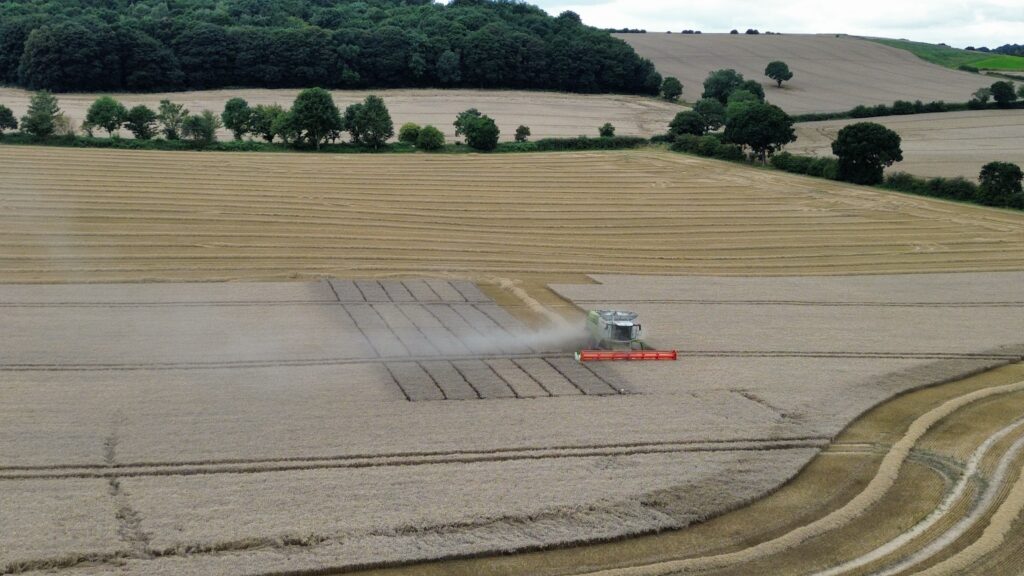October 2023
A year in farming is a long time, and blimey what a difference a year makes! 2022 and 2023 could not have been different in terms of weather!
This year had the hallmarks of the previous two years, a relatively dry winter and spring looking as if it would continue the trend, and then it rained! I’ll admit the rain in June was welcome on our light sandy land, it gave the crops a late dose of water which they missed out on last season when they started to die off in the heat rather than ripen.
One of the biggest benefits we’ve found from direct drilling, is the increase in soil organic matter and improved soil structure, enabling us to better pick the opportunities for fertiliser and spraying work as the ground carries the machinery weight much better than conventional cultivation systems allow.
Growing a mixture of 1st wheats for milling after Oil seed rape and second wheats gives a 1 in 3 year rotation.
Oil seed rape, like many other farmers continues to be a challenging crop to establish and take through to a successful harvest, I often wonder why we persevere with it, direct drilling has reduced the establishment cost significantly and this year we plan to try a companion crop to entice the cabbage stem flee beetle away from the OSR.

The majority of the OSR looked patchy for much of the winter, I took the decision to take out an area of around 5 acres as it just didn’t grow early on in the year, we later decided to plant a cover crop of buckwheat in the spring in the whole field, it’s possibly the best crop on the farm, given the increase of cover crop seed costs, we seriously considered combining it for the seed, oddly my combine contractor wasn’t so keen, not sure if it was the fact it was 5ft tall or how green the plant was!
Given how the crop looked earlier in the year, by June it was looking a lot healthier.

Harvest finally got underway on the 1st of August, which is around the ‘normal’ time, 2021/22 were earlier due to the heat we experienced which burnt crops off.
The 100 acres of OSR averaged 1.4t to the acre, which is an all time record high for the crop since we’ve grown it here. I’ve yet to sit down and work out the exact costs, but will happily share once I have, that might determine how much the risk vs reward I’m prepared to continue with every year, its a good break crop and rotation is key to all systems not just direct drilling.
Wheat harvest began on the 9th of August with Skyfall milling wheat, the wheat looked good all year and the hope was that they would yield equally as well.
We contract out our combining and this year a newer Claas Lexion 760 was all set up for Yield mapping, something we’ve never had the ability to do with previous machines.

There’s still some work to do to get the best from the data from the combine, Sky drill and the tractor, if the technology allows us to trim seed rates and input application rates, there has to be benefits not only on costs but environmental as well.
The sky drill now has section control working on it, this should reduce overlapping on headlands and a reduction in seed requirement.
The milling wheat averaged 9.4t/ha with the 2nd wheats averaging 9.1t/ha. The combine yield mapping showed areas of over 12t/ha.
Interestingly, the worst performing wheat was the ground that had been used for the ploughing match last year, it yielded an average of 8.9t/ha, not a huge difference from the other 2nd wheat but it took significantly more metal, fuel and time to create a seedbed. Pictures taken in January show just how different the ground conditions were between two fields, pretty easy to determine which was the direct drilled ground!


We don’t bale anything here, the straw is to valuable a bi product to let off the farm and it also reduces the extra traffic caused by bailing, we aren’t fully controlled traffic but the tramlines will be staying put this year and try our hardest to keep trailers on the headlands and tramlines where possible.
The chopper and spreader achieves a much more even and wider spread than the previous one, so much it’s pretty much negated the requirement of the straw rake this year other than to try and promote a chit to the stubbles, using it to scratch the surface and mix ant seeds with a bit of soil seems to work.
At the time of writing we planting a cover crop mixture of buckwheat, vetch, radish, linseed, faccelia and clover into OSR stubble at a rate of 30kg/ha before the milling wheat, at a cost of towards £7,000 for the seed, let’s hope it grows!
The grain store is full with ours and neighbours’ crops, the dryer has finally stopped running and the results from the milling wheat samples are back, 12.9 % protein, 79 bushel weight and between 220-280 hagberg, we just need the price to go up a bit now!
2023 has been a better overall yielding harvest, up on the last 5 years average, with improved quality, without doubt soil health has improved, dig anywhere on the farm and you get lots and lots of worms, the soil looks and smells different and there’s much more wildlife about the farm, I suspect down to having ground cover of some sort all year round.
2024 OSR is about to go in the ground with a `Beetle buster’ companion crop of buckwheat and Fenugreek to tempt the CSFB, providing we don’t get too much more rain, autumn drilling should be relativity straight forward, but just as we started this piece, a lot can change during a year in farming.


